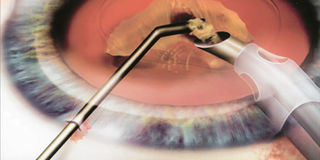Nairobi joins the best in vision care

The Phaco technology which is the gold standard for cataract operation. Photo/FILE
What you need to know:
- Biggest cause of blindness among young people is Keratoconus - anterior part of the cornea becomes like a cone and out of shape.
- Current management of keratoconus includes wearing hard contact lens which can further cause corneal thinning.
- Latest treatment is by cross –linking, where Riboflavin eye drops are put on the cornea after sliding few superficial corneal cells so that it can penetrate the cornea and then the ultra violet rays are applied.
The use of spectacles is an indication of a vision problem with glasses remaining the treatment of choice until a few years ago when Laser Vision Correction —Lasik— was introduced.
Here, the front part of the eye called cornea is re-shaped by the laser depending on whether one is short sighted (myopia ) or long sighted (hypermetropia ) or has a blurred vision (astigmatism).
The laser correction is done in the centre of the cornea which is known as the stroma.
In order to reach the stroma, a micro thin flap the thickness of contact lens is created by specialised device which is followed by application of exmier laser to re-shape the cornea and then the flap is laid back to the original position.
“This is a safe procedure, but very rarely it can sometimes lead to dry eyes, glare during night driving or some kind of an inflammation under the flap,” says Dr Mukesh Joshi of the Laser Eye Centre of Nairobi The technology was introduced three years ago at the centre and so far over 2000 procedures have been carried out.
Better than lasik
But because of the small number of people who may develop dry eyes or other minor complications , Dr Joshi explains, a new procedure called no- cut lasik and shown to have the highest safety record has been introduced.
Here no flap is made on the cornea but there is a cleavage line between the first and the second layer of the cornea which is separated and Laser is done there.
The Centre was the first institution in Africa to offer no –cut lasik, commonly known as Epi-lasik. Florence Martley of the Swiss Embassy Nairobi says she had the option of going to have the procedure carried out back home but opted to have it in Kenya. She is happy with the results.
A couple Andrew and Chritina Irwin who could also have had the Epi- Lasik operation in Europe opted for the Laser Eye Centre and now say their vision is above average.
“After years of procrastination and the inconvenience of glasses, I decided to go for Epi-Lasik and today I wonder why I waited for so long,” says Sapna Shah, a property developer in Nairobi.
The technology has also helped a lot of pilots locally and internationally and recently approved by NASA, because of its high success rates and safety levels.
Now Dr Joshi, a pioneer in the technology is a much sought after at international scientific conferences to share his experiences with a wider audience.
In June, for example, he was in both South Africa and Sweden to address different conferences; later he travelled to Maracash for the African Society of Refractive Surgery meeting.
In September he travels to Berlin as a guest faculty for the European Society Congress of Refractive Surgery conference while early next year he will be coordinating the Middle East African Society of Ophthalmologist Congress in Bahrain.
Currently, says Dr Joshi, the biggest cause of blindness among young people is Keratoconus.
“As the name suggests, Kerato means cornea and conus means cone. The anterior part of the cornea becomes like a cone — out of shape.
Cornea assumes an irregular conical shape which leads to deterioration and diminished vision.
If left un treated, cornea continues to become thinner and thinner leading to rupture of the inner layer and the becomes completely cloudy, a condition known as hydrops,” explains Dr Joshi.
The current management of keratoconus includes wearing hard contact lens which can further cause corneal thinning.
When keratoconus becomes advanced, then the corneal transplant is warranted.
Here the cornea is collected from a donor after death and the out of shape cornea is removed and replaced by the healthy donor corneal tissue.
The centre has for the last 25 years being doing cornea transplants.
The latest treatment in keratoconus is cross –linking. This has been considered as a major break through in keratoconus treatment.
Here, Riboflavin eye drops are put on the cornea after sliding a few superficial corneal cells so that it can penetrate the cornea and then the ultra violet rays are applied.
This inter action between the Riboflavin eye drops and the violet rays, leads to strengthening of the corneal stroma — about three times stronger and this is called cross linking.
Laser Eye Centre is considered as the first centre to offer cross linking in Africa and Asia.
Another major eye problem is cataract, usually treated through what is called Phaco, the gold standard for cataract operation.




